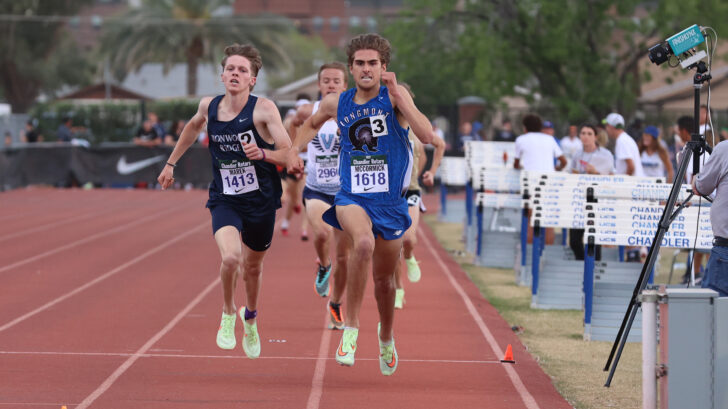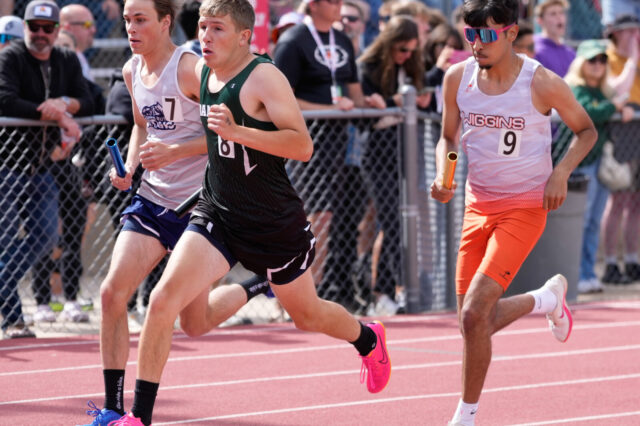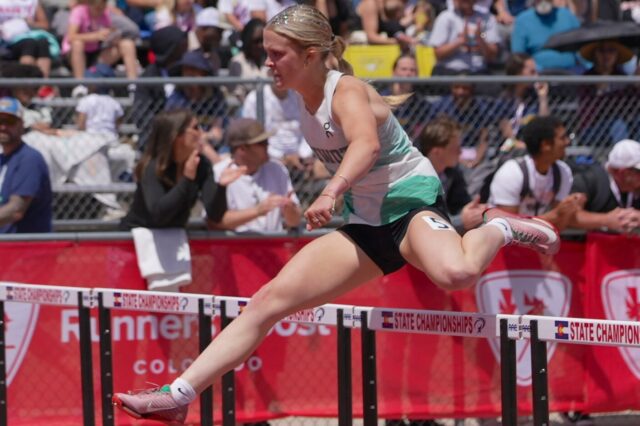About those Colorado Kids in Arizona…
At long last, a complete a readable set of results from Chandler Rotary arrived in my inbox a couple of hours ago. So, let’s talk about what the Colorado contingent showed in Arizona!
We’ll start by acknowledging that distance runners have the largest piece of motivation to head to Arizona to run a meet. I’ve coached enough distance runners to know that when you dangle the strong possibility of a PR, oxygen-deprived distance runners will beat a path to your doorway.
In a nutshell, that’s what happens about the late in March every year. It used to be a small trickle of Colorado athletes heading to Arizona for the Chandler Rotary. These days, it’s a lot more like a fire hose.
Sprinters and hurdlers, though, have no compelling reason—other than warmth—to head to Arizona. The air is thicker in Arizona, meaning times will be slower. If you’re wondering, yes, there really is a (negative) altitude adjustment in the NCAA for sprint times recorded at altitude. Colorado is a great place for sprinters to set PRs, and, consequently, it’s a tough place to leave.
We’ll start with the Friday results. Friday action was for athletes who didn’t make the cut for Saturday’s events. As you’re about to see, those cuts shoved a couple of very good Colorado athletes into Friday.
In the girls’ 1600, Elle Stevens of Colorado Springs Christian School ran 5:34.17 for second place. A little later in the evening, Chandler Wilburn of The Classical Academy ran 9:51.81 to take the win in the boys’ 3200. Aiden Wiescamp of Legend ran 10:05.79 for third. For Wilburn, that checked in as a PR. For Wiescamp? Well, he’s a totally new name on my radar screen. Nice debut effort, though!
Saturday brought the bigger part of the Colorado show with it. There was a very good number of Colorado athletes in action. Please understand that I can only hit the highlights here.
Gianna Kirking of Ralston Valley was one of those few sprinters who make the trip down. She responded with a 12.85 for ninth place. That’s a bit off her Colorado PR, but when you stay below 13 seconds in the greater Phoenix area, you’re doing well. Kirking would later post a 59.75 in the 400, which did count as a PR.
Zander Cruzan of Montezuma-Cortez also ran in the 100, finishing third in 11.11. That was .01 off his PR, set in prelims at state last year. There are bigger things in store for Mr. Cruzan.
In the non-seeded 1600s, Alex Lancaster of Valor Christian ran 5:23, while Nate Lumaye of Air Academy ran 4:33. Both of those times register as PRs.
Jocelyn Millican’s 58.73 400 meters was good enough for second place and a PR. I’m guessing the PR means more to her, but it is potentially a difficult question.
Elijah Quinby of Longmont ran 41.30 to take second in the non-seeded 300 hurdles. That’s better than a full second of PR for Mr. Quinby.
In the non-seeded 800, Ava Lane of Basalt proved she belonged in the seeded heat, winning by almost seven seconds at 2:17. Elle Stevens went 2:25 for fourth.
Frederick Ambrose of Niwot led the Colorado charge in the non-seeded 3200, finishing fourth in 9:38. If that seems to you like a time that should have been in the seeded heat, well, you evidently haven’t yet seen the times posted in the seeded heat. Everything happens within a context.
We now reach the seeded events, the ones that it takes most of the day Saturday to get to. But, it was worth the effort to take note of these performances above. The non-seeded athletes go down to Arizona to do big things, too. To skip over these would be to ignore a very large share of why this meet is important to so many Colorado athletes.
In the 110 hurdles, Valor’s Jack Wetterling took third in 15.06. It doesn’t matter for Colorado rankings, but that mark was wind-legal. That was better than half a second of PR for Wetterling, and the drop in elevation was assuredly a handicap.
The Colorado contingent was all over the seeded girls 1600/Mile. Colorado claimed the first six places, led by Eva Klingbeil in first at 4:47 and Brooke Wilson in second at 4:54. The rest of the top six (Shults, Michalak, Walter, and Parks) were merely under 5:02. It’s a tough crowd when they go to Arizona to race. Klingbeil would double back later to win the 3200 in 10:17, 16 seconds ahead of Keeghan Edwards (Valor Christian) in second.
It was still a nice showing, just not quite as dominant, in the seeded boys 1600/Mile. Connor McCormick took the win in 4:12, with Drew Costelow coming up in third at 4:13. Deeper into the evening, McCormick added another win in the 800 with a sizzling time of 1:51.90. Of the two, I’d pick the 800 as a better time, but both were outstanding. McCormick went down to Arizona to race, folks.
Kennedy McDonald found the path to sixth in the seeded 800 with a 2:19, just ahead of Jocelyn Millican.
Joey Hendershot led the Colorado finishers in the seeded boys 3200 at 9:14. That was only good enough for fourth this time around. Longmont’s Dominic Warner was seventh in 9:16.
Colorado participation in the field events was, in a word, scant. One who did make the trip down, however, was Caleb Johnson of Longmont. Mr. Johnson went 44-2.5 in the triple jump for seventh place. That was good for 2.5 inches of PR, advancing a mark set only one week prior at the Murray Kula Invitational.
With this meet in the books, we can concentrate a little more decisively on meets happening within the borders of Colorado going forward.
I’ll use the remaining space in this article to answer a trivia question I posted here earlier and to put in a teaser for my next article.
As to the trivia question about which Colorado schools have a mascot of Miners, those schools would be North Fork, Creede, Prospect Ridge Academy, Telluride, and Trinidad. Coal would be the mining objective of choice that inspired the mascots at North Fork, Prospect Ridge Academy, and Trinidad. In Creede and Telluride, silver was the driving force behind the mining activity.
Next up will be the first of what I call the Deep Dives. We’ll take a very close look at how the 2A Girls state title hunt is shaping up. The series will continue at least until I’ve completed both sexes for all five classifications. There’s a good chance I’ll update a Deep Dive or two at the end where new information has emerged.
Be on the lookout for those articles!



